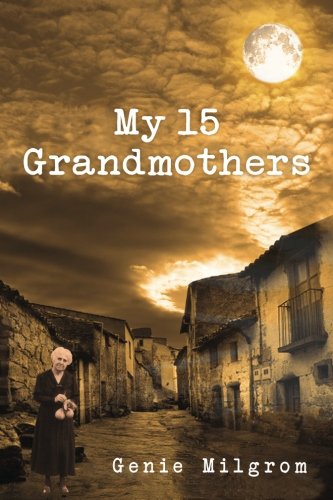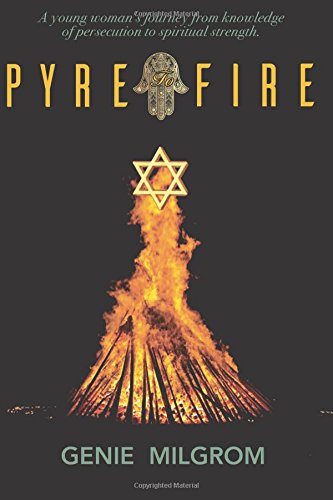Genie Milgrom
MY 15 GRANDMOTHERS
CreateSpace Publishing, 2012, ISBN: 1478297077
and
PYRE TO FIRE
CreateSpace Publishing, 2018, ISBN: 97819764519
Reviewed by Seth Kunin1
Genie Milgrom’s two books, My 15 Grandmothers and Pyre to Fire, are closely related in content but aimed at different audiences and utilize different literary genres. My 15 Grandmothers takes the form of a memoir. It traces two parallel journeys. The first is the author’s journey from a Catholic Cuban upbringing to her conversion to Judaism and a Jewish identity. The second journey is one of discovery of roots and familial history. The author presents a narrative of her search for her ancestors in Spain, based on genealogical and historical research — with the memoir recounting her reconstruction of this genealogy and history. Pyre to Fire is written in the form of fictionalized history. It utilizes the historical research and the discovery of identity presented in My 15 Grandmothers as its source material. Like the memoir it too, comprises two interrelated journeys. The main narrative thread recounts the story of a Jewish family living on the border between Spain and Portugal and their decisions in the face of increasing persecution and forced conversion to Catholicism — they choose to convert with the specific and premeditated intention of maintaining their Jewish identity in secret. A second narrative thread, interspersed with the first, brings us to the 20th century. It focuses on Maria (who is a fictionalised version of the author) touching on key points in her journey from her Catholic upbringing to her recovery of her Jewish identity.
As an anthropologist who has studied crypto-Judaism for close to 25 years the material in these two books presents important documents that provide an important window into the understanding of crypto-Judaism. Due to their different genres, despite their overlap in content, the two books are interesting in very different ways.
The memoir is a document about identity. It traces the author’s retrospective self- understanding and interpretation of her movement from a Catholic to a Jewish identity. This movement utilizes a number of interrelated tropes: dissatisfaction with the Catholic way of understanding the world, an affinity with the Hebrew Bible rather than the New Testament, grandparents who do things in a different way, discovery of genealogy and historical material that links with Jewish ancestors, and recovery and embracing of Jewish identity. Each of these tropes is exemplified in the ethnographic analysis of narratives told by individuals from the Hispanic community who are exploring their possible relationship with a Jewish past and Judaism.
Analysis of crypto-Jewish identity recognized three overlapping categories of crypto-Jewish identity: the first in which the identity is strong and ongoing; the second in which the identity is learned later in life either through research or family narratives; the third in which the identity is based solely on feeling. These three identities are not fixed, as individuals move through life and self-understanding they may express their identity in each of these ways. The memoir provides a fascinating insight into this process. While it is clearly written at a point in which the author has reached a settled and strong Jewish identity, it recounts a movement through at least two of these categories. It moves from an identity based on feeling to one based on evidence and history both in her immediate past with her grandparents and ultimately in her discovery of Jewish origins back to the 15th century in Spain. The memoir uses the above tropes, as do other crypto-Jewish narratives to validate this expression of self-understanding.
Pyre to Fire, while utilizing the same source material, must be understood and analysed in a very different way. The book recreates and seeks to understand the motivations of Jews in 15th century Spain for choosing to convert to Catholicism and how this conversation relates to their maintenance of both Jewish identity and practice. While such reconstructions are interesting thought experiments in themselves, it is perhaps essential to view them as expressions (particularly in this case) of the author’s attempt to explain and understand her own identity and validate why her ancestors made these choices — that is to say it is more about the author than it is about the period it describes.
From this perspective, the novel fits into an interrelated set of crypto-Jewish narratives that seek to address similar questions and all of which are structurally identical. They address the problem central to crypto-Jewish identity, if we are Jews how can we also be Catholic — ultimately the narrative undermines the Catholic identity and thus validates the Jewish identity. An example of this type of narrative was told to me in New Mexico:
When my grandmother was born her family lived in the mountains, there was no church. They needed to go to Santa Fe to baptise the baby. On the way down the wagon hit a bump, the baby fell off but no one noticed. They got to the church, but no baby. The Priest still wrote the name in the baptismal register. On the way home, there was the baby by the side of the path (Kunin. 2009. p. 125)2.
This narrative resolves the crisis of identity by denying that,despite inclusion in the baptismal record, the baptism and hence Catholic identity ever was significant. Milgrom’s novel is structured in the same way. It seeks to resolve the challenge of crypto-Jewish identity by denying that the conversion was ever real. In her narrative, the family consciously develops a plan to circumvent their persecutors — they decide in a planned and premeditated way to publicly convert while secretly maintaining their Jewish religion and identity. On this basis, the novel asserts that they, and by implication their descendants, were never really Catholic. On this basis as an expression of crypto-Jewish narrativization, and as part of a wider genre of crypto-Jewish myth, folklore, and stories, this novel is an important and valuable contribution.
That being said, it is important to introduce one caveat in the way one might use the two books as a resource. My 15 Grandmothers is a nuanced and carefully written book. While it is clearly as all memoirs are a recreation and reinterpretation of the past, it is minimalist in its presentation of practices and identity, especially in relation to the early parts of the author’s life. It does not seem to be a compendium of all potential crypto-Jewish practices, but rather an attempt to authentically (to the extent possible) capture and present the author’s experience and understanding of that experience. Pyre to Fire, perforce, goes well beyond the author’s experience. It brings together a wide range of crypto-Jewish practices, many of which were not part of the author’s own experience. It also tries to explain the historical origin of these practices, through reconstruction. The material in the novel, therefore, cannot be used in the same way as the memoir, and must be taken more carefully as a depiction of crypto-Jewish lived experience. Modern ethnographic evidence suggests that each family had a subset of practices rather than the extensive range indicated in the novel. It is also important to question the overly conscious and premeditated depiction of the conversion and the development of associated practices — it seems more likely that these were more organic and evolutionary processes.
Despite this caveat, this review suggests that both My 15 Grandmothers and Pyre to Fire are important contributions to the literature by and about crypto-Jews. In different ways both books allow us to better understand the lived crypto-Jewish experience. They are also on a different level an important popular contribution helping the wider community better understand this significant aspect of the modern Jewish community.
1 Professor Seth Kunin is Deputy Vice Chancellor, International at Curtin University in Australia. He has researched and written extensively on crypto Judaism for the last 25 years.
2 Kunin, Seth. 2009. Juggling Identities. Columbia University Press: New York.


